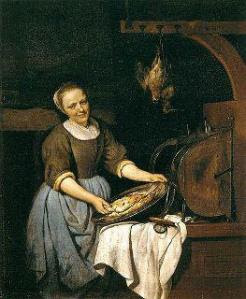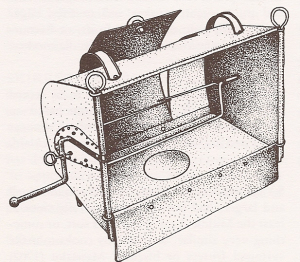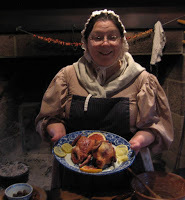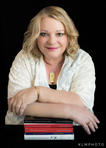Reflector ovens…in the 17th century?!
© March 9, 2012 by Carolina Capehart
On Facebook recently [2012] there was quite a lively discussion, as well as plenty of oooohhhing and ahhhhhing, amongst my assorted friends about the tin (or is it copper?) reflector oven that’s depicted in the painting below:

This is entitled simply “The Cook.” It was done by the Dutch painter Gabriel Metsu (1629-1667) and was most likely completed by him at some point between 1657 and 1662.
Yes, you read that correctly: between the years 1657 and 1662. Indeed, Metsu was a mid-17th century painter.
Now, I’ll be the first to admit it: I thought these ovens were only in use during the 19th, maybe the very late 18th, century (at least here in America). I’m not really sure why. I’ve used them often, but I’ve never really given it much thought. I’ve never investigated whether they were available/used earlier. Of course, I’ve done quite a bit of 18th century hearth cooking, but my main focus has typically been the 19th. Not to mention, that’s the time period in which I was initially trained (at Conner Prairie, back when the year 1836 was the focus). However, based on this painting, apparently reflector ovens were around, even as early as the mid-1600s.
At the same time, though, it is a Dutch painting. So perhaps reflector ovens were common in Europe, even during the 17th century, but were they also used on this side of the pond? It seems likely that they may’ve been imported. Or perhaps they were made here. However, I think it is generally believed that being a tinsmith was more of an 1800s profession. You know, due to British control of manufactured goods, that sort of thing. Or, perhaps not? It’d definitely be interesting to research this further, and to look at store inventories, newspaper ads, ship records, and other assorted documents, to see if, and when, such ovens were made in, or transported to, the colonies.
In any event, when this painting and the ensuing discussion took place on Facebook, I remembered a passage I’d read in Prospect Books’ facsimile reprint of Hannah Glasse’s book, The Art of Cookery, made Plain & Easy (1747). In the glossary is this definition (and illustration) of “Tin Oven”: The reference to a tin oven, [on page] 91, is to the ‘Dutch oven’ which was in common use and which stood in front of the fire. The food being cooked was exposed to direct heat and also to reflected heat from the polished tin interior. A door in the back could be opened to permit viewing and basting.
 Now, what’s interesting is that all the receipts on page 91 in Glasse’s book are for fish, and only one specifically calls for cooking the dish in “a Tin Oven.” It’s the receipt [recipe] “Salmon in Cases.” The instructions say to wrap salmon pieces in paper and “lay them on a Tin Plate.” It then states that “a Tin Oven before the Fire does best” (I imagine as opposed to a brick bake oven). Which, of course, obviously means that the fish is not put on the spit!
Now, what’s interesting is that all the receipts on page 91 in Glasse’s book are for fish, and only one specifically calls for cooking the dish in “a Tin Oven.” It’s the receipt [recipe] “Salmon in Cases.” The instructions say to wrap salmon pieces in paper and “lay them on a Tin Plate.” It then states that “a Tin Oven before the Fire does best” (I imagine as opposed to a brick bake oven). Which, of course, obviously means that the fish is not put on the spit!So, in a typical tin reflector oven, where would you put a plate of fish “in cases”? On the floor/bottom of it? But that puts it too low in relationship to the fire, yes? So, in order to gain some height, could the plate perhaps be balanced on top of the spit? Could that work, would it stay securely? (I’m thinking maybe, but not likely?) Then I thought, “Well, perhaps Glasse means one of those tin ovens with a shelf? The ones that are often used for small breads (either loose or in a pan)?” And if so, does that mean those types of tin ovens were also around in the early to mid 18th century? Makes perfect sense, yes? Or no? And so, is there possibly a slight problem with this glossary’s definition of “Tin Oven”: i.e. it’s not just the ones with a spit and basting door, but it’s also other types?
Luckily for me, I was scheduled to cook again at the hearth in the kitchen of the Israel Crane House on Sunday, March 1, which meant I’d be able to conduct my own experiments.
I could figure out just how this fish receipt was to be cooked. What fun!
So, stay tuned!
For the results of Carolina’s experiment with reflector ovens, along with photos, see her blog article: https://firesidefeasts.wordpress.com/2012/03/15/a-tin-oven-before-the-fire-does-best/
***** ***** *****
 Carolina Capehart, who passed away in April 2017, dabnabit (one of her favorite words), was a friend of those of us who study and report on the 17th century. This is my remembrance of Carolina: http://marybarrettdyer.blogspot.com/2017/09/big-respect-for-departed-friend.html
Carolina Capehart, who passed away in April 2017, dabnabit (one of her favorite words), was a friend of those of us who study and report on the 17th century. This is my remembrance of Carolina: http://marybarrettdyer.blogspot.com/2017/09/big-respect-for-departed-friend.html
Published on October 30, 2017 16:50
No comments have been added yet.



